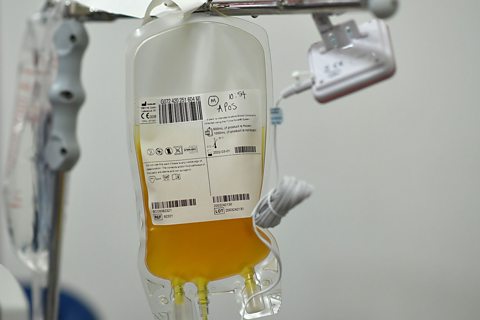What are the four components of the blood?
Blood has four main components: red blood cells, white blood cells, platelets and plasma.
These are the functions of each component.
| Component | Function |
|---|---|
| Red blood cell | To carry oxygen from the lungs to every cell in the body |
| White blood cell | To fight infection by micro-organisms and stop other diseases |
| Platelets | Broken down parts of cells that clot the blood |
| Plasma | A liquid that carries the blood cells and platelets around the body |
There are different amounts of the four components in the blood.
Red blood cells
Red blood cells are the most numerous cell in the blood. In one drop of blood there are around 3-5 million red blood cells. They are made in the bone marrow.
Oxygen moves by diffusion into red blood cells in the lungs. They have a chemical inside them called haemoglobin, a red pigment which binds with the oxygen to carry oxygen to where it is needed in the body.
Red blood cells do not have a nucleus to maximise the oxygen they can carry. They have dips on both sides to maximise their surface area to absorb oxygen as quickly as possible. This shape is called biconcave.
White blood cells
White blood cells form part of the immune system to keep us safe from infection and other diseases (e.g. cancer and foreign bodies inside you). There are 10,000-20,000 white blood cells in one drop of blood, and even more when a person is ill. They are made in bone marrow.
There are two types of white blood cell:
- Granulocytes, which surround, engulf and destroy germs
- Lymphocytes which produce antibodies that stick germs together. This makes it easier for granulocytes to destroy them.
Granulocytes ‘engulf’ pathogens rather than ‘eat’ them because they do not have a mouth.
The two types of white blood cell. Granulocyte (left) and lymphocyte
Platelets
Platelets are small, colourless fragments of cells that stop cuts from bleeding. There are several hundred thousand platelets in each drop of blood.
Like red and white blood cells, platelets are made in bone marrow.
Plasma
Plasma is the liquid that makes up more than half of the blood in a human body. It is mainly made of water and is pale yellow so is often called ‘straw-coloured’.
It carries all the platelets and red and white blood cells around the human body. It also carries hormones, dissolved glucose and salts, and enzymes, around the body. Waste products like carbon dioxide are also transported in the plasma.


